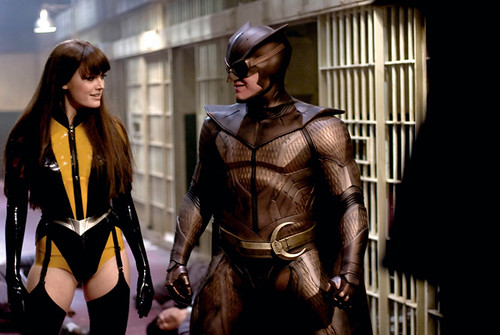Malin Akerman & Patrick Wilson have all the emotional power of Ken & Barbie
This is the golden age of movie effects, or at least it should be. Computer graphics have been enhanced to the level that anything is possible, anything you can dream of can be presented as a plausible physical reality on film, a phenomenon that leaves directors, screenwriters & stuntmen drunk with the potential. Yet the problem remains that for the golden age to actually exist, these same individuals have to envision it, have to make it happen. Just as early motion pictures owe a great deal of their narrative structures to the imaginations of D.W. Griffith & Sergei Eisenstein, men who figured out how to transform a story into the new medium, the potential of today’s film technology is just waiting for someone to come along and imagine what it truly might be.
The problem, however, is that
Director Zack Snyder has tried to do something new & brave in Watchmen, which is to reinvent cinema completely. Part of what results is awe-inspiring, genuinely breath-taking, as ambitious in its own right as was Todd Haynes’ Dylan faux-biopic, I’m Not There or anything ever written by Charlie Kaufman. And parts of it are leaden, tedious, so corny that they leave you guffawing, such as the sex scene in which Nite Owl II, having cured his erectile function disorder through a night of good old caped adventures finally gets it on with Silk Spectre II, woodenly portrayed by Malin Akerman (an actress who could take lessons in the thespian arts from Paris Hilton), while Leonard Cohen gravels through Hallelujah, the soundtrack turned so loud it’s the foreground.
Snyder has pretty much abandoned action-picture dynamics (think the new Bond films or anything with the word Bourne in the title) altogether, and instead has tried to make the graphic novel. Complete with Alan Moore’s long prose asides that in the original comics took up a full page in every episode. He’s abandoned cinematic pacing. What he wants is something that doesn’t look or feel like a film at all, that is as new to the genre as Watchmen was to the world of comic books when it first appeared a quarter century ago.
Narratively, Snyder has added relatively little, tho most of what is new, like a martial arts fight scene down a prison corridor by Nite Owl II & Silk Spectre II done as a parody of superhero fighting, distracts or detracts. He’s also sliced away relatively little, which given the size of the graphic novel is almost surprising. Where he really has added is a dimension you can’t get in comics, which is the score, from the strains of Bob Dylan singing “The Times They Are A’Changin’” over the most leisurely opening credits I’ve ever seen – the first real hint that we’re not in regular old movie land – to Simon & Garfunkel singing “The Sounds of Silence” during the funeral of The Comedian to a punk version of “Desolation Row” in the closing credits by My Chemical Romance. As with Leonard Cohen during the film’s principle sex scene – as explicit as anything I’ve ever seen in a picture aimed at adolescent males – the presence of Simon & Garfunkel plays against the action, a moment of very strange irony that
Where the film really doesn’t work is in the acting. Snyder – rather like George Lucas – moves the cast about & has them say their lines, but often with no affect whatsoever. So that the only performers who shine through at all are veteran character actors: Jackie Earl Haley’s Rorshach, Jeffrey Dean Morgan as The Comedian, a cameo by Matt Frewer (Max Headroom himself, this time with pointy ears) as Moloch, the villain befriended by The Comedian shortly before his demise, and Robert Wisden’s caricature of Richard Nixon, with a ski-nose right out of the editorial cartoons. It is really Haley who saves this film as film, and its very best moments are the ones where is he is free of his character’s gauzy, perpetually changing mask.
But I wouldn’t judge the actors here – save maybe for Akerman, who should be an early favorite for next year’s Razzies for that sex scene alone – on the basis of their work here.
The end result is that Watchmen is like viewing a beautiful train wreck in very slow motion. You can’t quite look away – save for the moments when limbs are being severed, which is a regular enough occurrence. Watchmen may even turn out to be an important film as film for all that it tries to do, but that will never make it a good one.
Still, it has a decent shot at being the Best of the Bloated among this year’s CGI-enhanced action spectacles. With Terminator Salvation, Star Trek (the prequel) & something to do with poor Wolverine of the X-men franchise all in the offing, not to mention the new Transformers, G.I. Joe & good ol’ Harry Potter, we’re in for a lot of special effects, none of which will take place in the writing. Safe scripts, franchise-familiar characters – that’s the name of the game, alas. Snyder at least has taken the riskiest project and done his very best to give us something completely new to look at. It is enough to make you ask of cinema – is that all there is?






